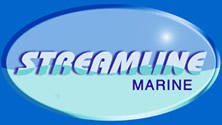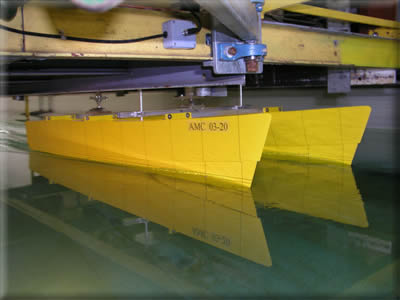 |
|
|||||||||||||||||||||||||||||||||
Performance
When it comes to performance the STREAMLINE MARINE Displacement Catamaran outperforms many monohull vessels, because it has been strategically designed to ensure speed, fuel efficiency and power.
How displacement affects performance…
All boats operate as displacement craft. In other words they will displace exactly the same amount of seawater as the total weight of the vessel. To put it simply, in order for the vessel to move forward, it must push the seawater aside.
 The water forms a wave, visible down the length of the vessel and
referred to as the displacement wave. As the vessel increases speed,
the displacement wave also increases until a point is reached when
the vessel must climb up over the wave to travel faster. The traditional
displacement yacht is unable to achieve this as any extra energy is
entirely consumed by the wave.
The water forms a wave, visible down the length of the vessel and
referred to as the displacement wave. As the vessel increases speed,
the displacement wave also increases until a point is reached when
the vessel must climb up over the wave to travel faster. The traditional
displacement yacht is unable to achieve this as any extra energy is
entirely consumed by the wave.
The speed at which this point is reached is called the hull speed of the craft - primarily determined by the hull length to beam ratio.
What makes a Streamline Catamaran superior?
The STREAMLINE MARINE Displacement Catamaran operates exactly as the traditional displacement launch but because the long narrow hulls have a length : beam ratio in excess of 15:1 the displacement hull speeds are frequently over 30 knots, but still requires very little power to achieve these speeds.
This provides the excellent fuel efficiency. As the payload is increased, the length to beam ratio alters very little, so the performance of the vessel is not affected.
With conventional materials i.e. aluminum, plywood or solid polyester/vinylester fiberglass construction, weight and strength could not be balanced sufficiently.
Aluminum is very sensitive to flexing and develops cracks after a determined amount of wave cycles. To reduce that risk, the material thickness and weight has to be increased just for the fact of durability. Further problems of electrolytic corrosion have to be monitored very carefully.
Polyester/Vinylester resins in Fiberglass constructions are hydroscopic and can absorb water, which results in the extreme in blisters on the skin called osmosis. Those resins also create a weaker bonding in tensile strength and stiffness.
To increase the narrow hull-lines and the performance, the STREAMLINE MARINE Catamarans are built out of high-tech Composite materials, which reduces the weight and increases strength and durability.
Only Epoxy Resins combined with Fiberglass, Carbon fiber and Kevlar and built as composite structures are used in STREAMLINE MARINE Catamarans.
The result in performance is that our Catamarans achieve speeds in the range of 25-32 knots with equivalent power of a monohull performing in the 10-15 knot range.
For the 78 ft STREAMLINE MARINE 24 the results of the Tank-Testing by the Australian Maritime College promise speed in of 28+ knots. In the fully loaded condition ( 22.8 tons) it needs for that speed an effective power of 386 kW. With the planned engine horsepower of 800 – 880 HP ( 2 x 440 ) this speed is expected to be exceeded.
How do traditional vessels compare?
A typical monohull craft will have a length : beam ratio of 3 or 4 to 1, which will give a hull speed of no more than 8-9 knots, but requires little power to achieve this.
A modern planing monohull uses its hull form, angled to the surface of the water, to convert forward thrust into lift. This raises the vessel out of the water and the vessel no longer pushes the full equivalent of its weight aside into the displacement wave, thereby eliminating the hull speed restriction. Speeds of 30+ knots can then be achieved.
This unfortunately comes at a cost of a huge increase in power as a large proportion of the power used for forward thrust is consumed to generate the lift.
A semi-displacement launch has a hull form unable to produce enough lift to raise the vessel sufficiently to eliminate the displacement wave entirely, but manages to reduce the amount of water pushed into this wave, which then consumes less energy, and allows for a higher hull speed, frequently in the 12-20 knot range.